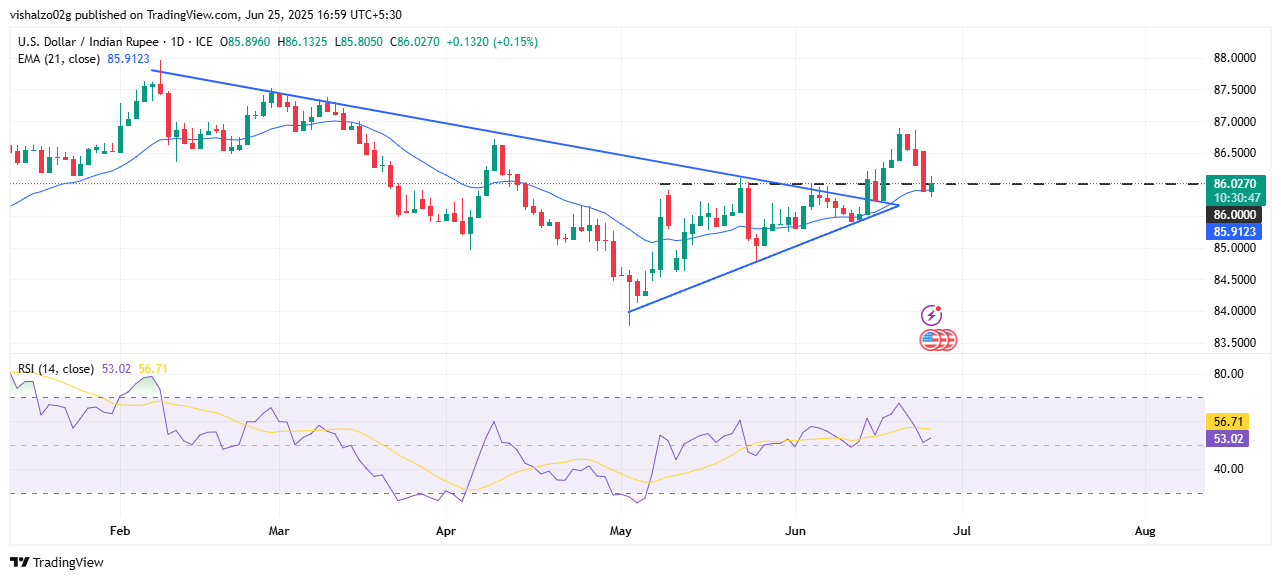
- USD/INR steadies above 86.00, snapping a three-day losing streak after rebounding from 21-day EMA support near 85.80.
- The Indian Rupee weakens despite easing geopolitical tensions, as importer demand for the US Dollar and cautious risk sentiment cap gains.
- Fed Chair Powell maintains cautious tone, signaling not rushing to cut rates, focus shifts to Senate testimony on Wednesday.
The Indian Rupee (INR) weakens against the US Dollar (USD) on Wednesday, surrendering early gains as the Greenback steadies. The Rupee opened on a firm note amid favorable risk sentiment but eased lower through the session as the US Dollar Index (DXY) held its ground near the previous week’s low. Meanwhile, Crude Oil prices remain stable after a sharp two-day sell-off, offering limited support to the Rupee.
The USD/INR is showing a mild recovery, halting a three-day losing streak as it rebounds from an intraday low near 85.80. The pair found support at the 21-day Exponential Moving Average (EMA) and is trading around 86.25 at the time of writing, during the American trading hours.
Geopolitical tensions in the Middle East have eased following a ceasefire agreement between Iran and Israel, bringing some relief to global markets. Oil prices have stabilized after a sharp two-day sell-off, and safe-haven demand has cooled, supporting broader risk sentiment. While the Rupee has moderately benefited from the de-escalation, its response remains subdued. The INR still faces pressure from steady demand for the US Dollar — particularly from oil companies — and remains sensitive to shifts in global risk appetite.
Market Movers: Rupee volatility persists; RBI acts on liquidity, Powell holds line
- The Indian Rupee posted its strongest daily gain in a month on Tuesday, though volatility persists with USD/INR swinging between ₹85.80 and ₹86.89 over the past week. The average exchange rate for June so far stands at approximately ₹86.00, aligning with the year-to-date average of around ₹86.10.
- In its June bulletin released Wednesday, the Reserve Bank of India (RBI) stated that the domestic economy continues to show strength despite global headwinds from trade disruptions and geopolitical tensions. The “State of the Economy” article emphasized that India remains on a stable growth path.
- “In this state of elevated global uncertainty, various high-frequency indicators for May 2025 point towards resilient economic activity in India across the industrial and services sectors,” the RBI said in its ‘State of the Economy’ article.
- RBI sees scope for inflation undershoot, trims FY26 forecast: the RBI said, “The near-term and medium-term outlook now gives us the confidence of not only a durable alignment of headline inflation with the target of 4 per cent… but also the belief that during the year, it is likely to undershoot the target at the margin.” Accordingly, the central bank revised its inflation forecast for FY2025–26 to 3.7%, down from the previous estimate of 4.0%.
- The RBI’s presence in the currency market has helped anchor the Rupee, with the central bank reportedly intervening through US Dollar sales at key levels to curb sharp depreciation. Market participants expect the RBI to maintain its calibrated approach, managing volatility while safeguarding foreign exchange reserves
- RBI signals liquidity shift, announcing plans on Tuesday to withdraw excess short-term cash from the banking system. The central bank aims to take out Rs 1 trillion ($11.6 billion) from the banking system via a seven-day variable rate reverse repurchase auction on June 27. This reverse repo operation, the first since November, is designed to align overnight call rates closer to the repo rate and may inject upward pressure into short-term money market rates.
- In the domestic equity market, the benchmark Sensex jumped 700.40 points to close at 82,755.51, while the Nifty surged 200.40 points to end at 25,244.75, buoyed by improved risk sentiment and easing geopolitical tensions.
- Crude Oil steadies after sharp drop, with Brent hovering near $66.60 and WTI around $64.30 on Wednesday. Prices have stabilized following a steep decline earlier in the week, as easing geopolitical tensions between Iran and Israel reduced fears of supply disruptions.
- Testifying before Congress on Tuesday, Federal Reserve (Fed) Chair Jerome Powell reinforced the Fed’s patient approach, signaling that a rate cut in July is unlikely. He emphasized the need for greater clarity on inflation trends and potential impacts from higher tariffs before implementing any policy shift. Powell’s remarks suggest that the Fed remains data-dependent, and rate cuts could be delayed until September or beyond. This cautious tone prompted a shift in market expectations, with traders dialing back bets on near-term easing.
- Following his appearance before the House on Tuesday, Fed Chair Jerome Powell is scheduled to face the Senate Banking Committee at 10:00 am EST on Wednesday for his semi‑annual monetary policy report.
- The US Dollar Index (DXY) remains firm around the 98.00 level on Wednesday, with traders staying cautious ahead of Fed Chair Powell’s second day of testimony.
USD/INR technical outlook: Retest in play, pair to trade in short-term range

USD/INR is currently trading around 86.03, retesting the breakout zone after slipping from recent highs. The pair found support near the 21-day EMA at 85.91, which aligns closely with the upper boundary of the symmetrical triangle pattern. The pair recently broke out of a symmetrical triangle but faced resistance below the 87.00 psychological mark, triggering a pullback.
The Relative Strength Index (RSI) on the daily chart is easing, hovering above neutral at 53.02, which indicates a loss of bullish momentum and suggests potential range-bound trading between 85.80 and 86.90 in the near term. A decisive break on either side of this range will likely dictate the next directional bias.
Indian economy FAQs
The Indian economy has averaged a growth rate of 6.13% between 2006 and 2023, which makes it one of the fastest growing in the world. India’s high growth has attracted a lot of foreign investment. This includes Foreign Direct Investment (FDI) into physical projects and Foreign Indirect Investment (FII) by foreign funds into Indian financial markets. The greater the level of investment, the higher the demand for the Rupee (INR). Fluctuations in Dollar-demand from Indian importers also impact INR.
India has to import a great deal of its Oil and gasoline so the price of Oil can have a direct impact on the Rupee. Oil is mostly traded in US Dollars (USD) on international markets so if the price of Oil rises, aggregate demand for USD increases and Indian importers have to sell more Rupees to meet that demand, which is depreciative for the Rupee.
Inflation has a complex effect on the Rupee. Ultimately it indicates an increase in money supply which reduces the Rupee’s overall value. Yet if it rises above the Reserve Bank of India’s (RBI) 4% target, the RBI will raise interest rates to bring it down by reducing credit. Higher interest rates, especially real rates (the difference between interest rates and inflation) strengthen the Rupee. They make India a more profitable place for international investors to park their money. A fall in inflation can be supportive of the Rupee. At the same time lower interest rates can have a depreciatory effect on the Rupee.
India has run a trade deficit for most of its recent history, indicating its imports outweigh its exports. Since the majority of international trade takes place in US Dollars, there are times – due to seasonal demand or order glut – where the high volume of imports leads to significant US Dollar- demand. During these periods the Rupee can weaken as it is heavily sold to meet the demand for Dollars. When markets experience increased volatility, the demand for US Dollars can also shoot up with a similarly negative effect on the Rupee.
Information on these pages contains forward-looking statements that involve risks and uncertainties. Markets and instruments profiled on this page are for informational purposes only and should not in any way come across as a recommendation to buy or sell in these assets. You should do your own thorough research before making any investment decisions. FXStreet does not in any way guarantee that this information is free from mistakes, errors, or material misstatements. It also does not guarantee that this information is of a timely nature. Investing in Open Markets involves a great deal of risk, including the loss of all or a portion of your investment, as well as emotional distress. All risks, losses and costs associated with investing, including total loss of principal, are your responsibility. The views and opinions expressed in this article are those of the authors and do not necessarily reflect the official policy or position of FXStreet nor its advertisers. The author will not be held responsible for information that is found at the end of links posted on this page.
If not otherwise explicitly mentioned in the body of the article, at the time of writing, the author has no position in any stock mentioned in this article and no business relationship with any company mentioned. The author has not received compensation for writing this article, other than from FXStreet.
FXStreet and the author do not provide personalized recommendations. The author makes no representations as to the accuracy, completeness, or suitability of this information. FXStreet and the author will not be liable for any errors, omissions or any losses, injuries or damages arising from this information and its display or use. Errors and omissions excepted.
The author and FXStreet are not registered investment advisors and nothing in this article is intended to be investment advice.








